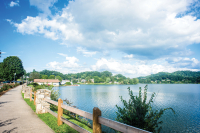Birdapalooza results
My brother and I conducted our annual Great Backyard Bird Count (GBBC) at Black Bayou Lake National Wildlife Refuge in Monroe, La., last Friday, Feb. 15. While we didn’t set any records, we had a good count. We bested last year’s total of 57 species by three and because of mechanical problems — a dead battery — we didn’t make it to the piney woods.
One of the best finds of the day was a blue-headed vireo. This vireo, along with plumbeous vireo and Cassin’s vireo, were once all thought of as a single species, the solitary vireo, but have since been separated into three species. The blue-headed is the most eastern of the three nesting across much of Canada and down the Appalachians to north Georgia. The blue-headeds that nest in the southern Appalachians are considered a subspecies — alticola.
Perhaps I’ll get to count the blue-headed we saw at BBLNWR again this spring when I’m doing point-counts for the Forest Service. While most blue-headed vireos migrate to South America for the winter, a large number of the alticola overwinter in the southeastern United States from the coastal Carolinas all the way to Texas. I have encountered blue-headed vireos in the winter at Magnolia Gardens, in Charleston, S.C. This individual was quiet striking. It must have just finished its molt into breeding plumage; the colors were fresh and vibrant.
Another good find this year was a marsh wren, heard calling and then singing a good portion of its song from a dense row of cattails along the edge of the lake. We also recorded five winter wrens and about a dozen Carolina wrens.
Ford, my brother, kept reminding me all morning that a local paper had recently run a photo of a bald eagle taken from a nearby community, ending the reminder each time with, “this would be a good place to find an eagle.”
It wasn’t the best day for raptors. The air was damp and the skies were overcast. We found a northern harrier and one red-tail hawk early in the morning, but we didn’t see anything else soaring till a lone turkey vulture turned up around noon.
Related Items
Then about one o’clock as we were headed out for lunch, I saw a large raptor circling in the distance. A look through the binoculars revealed an adult bald eagle, soaring just below a small kettle of six turkey vultures. Needless to say, I was reminded, more than once, that, “I knew this would be a good place to see an eagle.”
We also had another four-warbler day this year, with the same four species as last year. You couldn’t look up without seeing yellow-rumped warblers. We quit trying to count the butter butts and just listed 200-plus. We also had three pine warblers, one of which couldn’t resist singing a couple of notes, two common yellowthroats and two orange-crowned warblers.
Woodpeckers were also well represented with six species (sorry no ivory-billed) including red-bellied, yellow-bellied sapsucker, downy, hairy, northern flicker and pileated.
I didn’t know that my birding day would end at 2 p.m., but a dead battery seemed to indicate that parking back at the hotel until the problem could be rectified made more sense than parking in the middle of the refuge.
Still, 60 species, including great looks at a mature bald eagle that I should have known would be there, is a good day birding.









